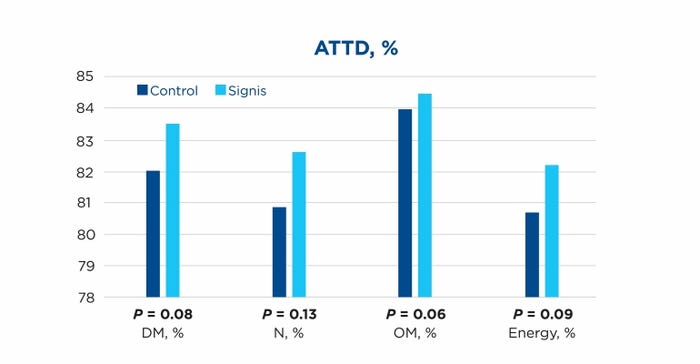Stimbiotic promotes fiber fermentation & optimizes performance in pigs
Feeding a stimbiotic may be advantageous in aiding nursery pigs
January 25, 2022

Sponsored Content
Nursery pigs are undoubtedly subjected to many stressors including, but not limited to, changes in nutrition, environment and health status. Feeding a stimbiotic may be advantageous in aiding nursery pigs in maintaining a positive trajectory by optimizing dietary fiber fermentation and increasing dietary nutrient utilization. Based on several recent trials in nursery pigs, the use of a stimbiotic (Signis, AB Vista) has resulted in improvements in feed efficiency and livability while decreasing the need for antibiotic treatments.
A stimbiotic is defined as a nondigestible, fermentable nonstarch polysaccharide source that stimulates fiber fermentation, resulting in increased volatile fatty acid production. These VFAs help to maintain gut integrity and serve as an energy source for the host, recovering some of the energy that would otherwise be lost. Unlike a prebiotic, this new stimbiotic classification does not directly provide enough substrate to the bacteria for direct VFA production. Instead, it shifts the population of bacteria in the gastrointestinal tract, which stimulates the growth and activity of beneficial bacteria such as Bifidobacteria. This effect can be explained by a direct stimulation of lactate- and butyrate-producing bacteria, with butyrate-producing bacteria often cross-feeding from lactate-producing bacteria.
The stimbiotic Signis is a dual-action product that combines an effective xylanase with specially selected xylo-oligosaccharides (XOS). There is clear evidence that xylanases can influence the fiber fermentation profile, the intestinal microbiome, and fermentation capacity. Fermentation capacity of the pig increases as the pig ages, so it takes time to develop the specific fibrolytic microbiota with a xylanase alone. Recently it has been shown that microbiome modulation by arabinoxylan-oligosaccharides (AXOS) produced by xylanase can improve the fermentability of dietary fiber. Furthermore, xylanase breakdown of fiber into different end products can favorably impact microbial fermentation. Research has shown that some factors are able to accelerate the establishment of a microbiome capable to more readily degrade fiber, enabling the beneficial effects from fiber fermentation to be achieved earlier. In fact, supplementing with Signis will both accelerate and increase the fermentative capacity of the intestinal microbiome. Supplementing nursery diets with Signis increases the ratio of VFA:BCFA, suggesting increased carbohydrate fermentation and decreased protein fermentation. Signis also decreases inflammation, as demonstrated by the reduction in systemic levels of the pro-inflammatory cytokine, TNF-α (Cho et al., 2020).

Pigs fed Signis in the nursery have a greater digestibility of nutrients (Figure 1) and, therefore, are more efficient (4% lower Feed Conversion Ratio; Figure 2). Considering the additional availability of nutrients and reduced inflammatory response in Signis-fed pigs, they appear better able to overcome challenges encountered in the nursery. Pigs fed Signis require fewer medications (Cho et al., 2020; Merriman et al., 2021; internal AB Vista data), have decreased diarrhea (internal data, submitted), and lower mortality (Figure 3), resulting in more full-value pigs coming out of the nursery. Therefore, the stimulation of fiber fermentation through supplementing a stimbiotic such as Signis increases animal robustness, extracts more nutrients from the diet and results in improved feed efficiency.


One of the derived benefits observed in relation to gut health and functionality is the increase in livability rates in pigs fed Signis. Based on data from 10 trials, the effect of Signis in increasing livability is greater when the livability of the control group is low, suggesting that Signis supplementation is able to mitigate subclinical pathological processes, favoring the health of the animals and resulting in increased livability.
About the Author(s)
You May Also Like



